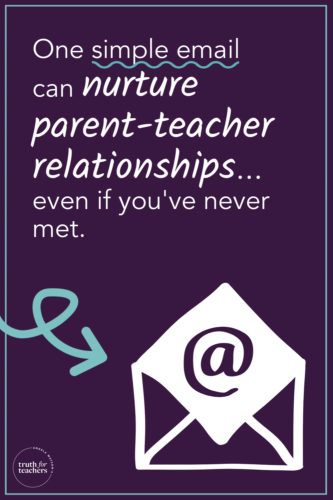At the start of this school year, many teachers and students were entirely engaged in remote learning.
With no shared history, building relationships became a greater challenge: how does a teacher connect with students in a remote environment, to create that relationship of trust and mutual respect and caring, so that learning can happen?
It’s widely accepted that relationships are key to a student’s learning. A student who enjoys a teacher’s class is likely a student who likes and admires the teacher. And while for some, relationships come naturally when in-person, in a remote environment, it can be a challenge for all teachers.
This year, I have been teaching at an entirely online, asynchronous private high school. I have no idea what the majority of my students look or sound like. They are not required to meet with me in a Zoom or Meet; they have the choice if they would like to attend my office hours.
It can be a lonely world sometimes. And if I’m feeling this way, how are my students feeling?

At the beginning of the year, I began composing weekly emails. Usually, I send them on Fridays. I was deliberate about the tone of each email: upbeat, warm, helpful, and friendly. With that, I decided that I should always have something personal in it — something where they could get to know me better, even if I might never really know them. I also thought about what a student or parent might actually want to read — what would make them click on it and skim through it, rather than deleting or ignoring it? I devised a plan for what I thought would be useful:
1. Start warm and get personal
I never used to talk much about myself in class. I guess I thought it wasn’t important. But this year, I realized that in order to form a connection with students, I would need to share more about what was going on in my life, what the weather was like where I lived, details about my pets and little tidbits about my family, and funny little anecdotes about my hobbies or recent encounters. And something interesting happened when I began to open up more: students started responding. After describing my new puppy, Lucy, in one of my emails, a student I’d never heard from before reached out to tell me about her pets. Since then, she’s visited my office hours and emails me regularly to ask questions. Coincidence? I don’t think so.
2. Recap on what’s been going on in class and give a heads up on what’s to come
Parents are generally clueless about what their kids are doing while they are at school, whether it’s in-person or remote. What I provide in each email is a brief summary of where most of my students are that week and what assignments they’ve been turning in. I also future-cast, filling them in on upcoming major assignments so they know what to be on the lookout for. Parents appreciate this because it gives them an in — if they know just a little bit about what their child is doing, they can spark a conversation and be more engaged with their child’s learning. It can also hook students and give them something to anticipate if I frame it right. It’s a win-win.
3. Synthesize what you’re seeing from students
Before I write my email, I think, What are some great things I’ve seen from students this week, and what is a common area of need? I try to synthesize, while also being specific. Now, that may sound ridiculous — how can you synthesize AND be specific? When I was in-person, I used to do it all the time. Think about the very best work you’ve seen, and tell students about it, in brief. You may choose to name-drop, if you wish (only if this is allowable, per your school’s policies, of course). Then discuss a common issue — maybe it’s issues with analysis, or maybe it’s internal citations, or perhaps it’s constructing a thesis statement … these are all things that you can either provide a quick, written or video tutorial on later in your email. This helps in two ways: to establish a positive tone and to show students I am noticing them, and says, I care, and I am going to work to help you.
4. Provide a helpful tip they can act on
Based on the area you observed that students need to work on, create a small, concise tutorial — whether typed or on video. Depending on the complexity of the topic (or if I’ve already made an instructional video), I’ll decide on how I might like to present it. Either way, it needs to be short. Videos should be no longer than five minutes, and a written tutorial should be no longer than a detailed paragraph. Sometimes, if I’ve written feedback for a student that I think would be universally helpful, I’ll copy and paste it into my email so that everyone can benefit from it. By making your emails useful and practical, more students are likely to look at them. Plus, when a similar issue comes up later on, you can say, “Hey student, please refer to my email from blah-blah and watch the short video I made” or if it’s saved as a Google doc, just copy and paste the link. Your emails can be a huge time saver and draw more students in as readers of your weekly email if students realize they are actually helpful.
5. Link in a resource or two
There is a plethora of useful information out there on the web; you just have to curate it for students. I love slipping in a couple of helpful links to students so that they can review them, bookmark them, and use them as a reference when they are working on assignments. I’ve had several students comment about how helpful some of the links I’ve provided have been.
6. Remind them that you care
Provide contact methods and encourage them to visit you, via their preferred method. I allow students to choose their method of contact, whether it’s email, phone call, texting, or visiting me during office hours. Students love choice and flexibility! While some may love cameras on and talking “face-to-face,” others prefer texting — it depends on the student’s comfort level. When a student reaches out, I do my best to respond quickly and with a cheerful, let’s-work-together tone. Of course, if it’s after business hours — 6pm in my book — I no longer respond and wait until morning. On weekends, I remain mute. It’s important to set and keep your boundaries. I even set a vacation message on my email on Fridays, just to remind students and parents that it’s the weekend and I will get back to them as soon as I can — on Monday.
7. End with a note on self-care
I always like to tell my students something about taking care of themselves — whether it’s taking a day to spend with family and friends, getting outside and being active, or spending time however they like to rejuvenate. In our busy world, we can all get so wrapped up in work and school that we forget to live. Sometimes, I’ll even insert a meme with a positive message or quote. It’s important to let my students know that I care about them as people — I want them to enjoy their lives, not just live to do schoolwork.
8. A final touch
Make sure you have pictures, whether they are photos, clip art, GIFs, or anything else that suits the topics in the email. I usually include at least one picture of something outside, whether it’s a flower in full bloom or a picture of deer wandering in my neighbor’s yard. I also like to include a picture of my dogs because who doesn’t love puppies? Clip art that suggests the topic of each part of the email is also helpful and keeps it visually attractive. If Facebook has algorithms that boost a post that features images, why wouldn’t it be the same for emails? We live in a highly visual society — there’s nothing wrong with catering to that in your emails.
Yes, it takes some time to compose one of these emails, and no, you don’t have to send one out every week. For in-person teachers, you might only send an email out once a month, or maybe even once a quarter. However often you decide to send them, think carefully on your subject line: you don’t want to be alarmist, but you also don’t want your email to get instantly marked for the trash. If your emails are sent out regularly, you may want to keep your subject line much the same and consider including the date. Considering that parents will also be recipients, you may want to include your course title, as parents may not remember or know who you are. Something like, “English Class Update for 5/21” may not be sexy, but it’s clear as to what the email is about and would be easy to find in a search down the road.
In this day and age of mondo accountability, your emails can be a valuable CYA tool when major projects are coming due. If you time your email so that you are sending it out at least a few days to a week before the due date, that gives parents and students time to plan and act. When you make them aware of major due dates and provide tips on how to be successful on an assignment, parents can help rally the troops, which results in more students turning in extended assignments on time.
And this really doesn’t have to feel like one more thing. You don’t have to compose your email in one sitting. What I like to do is start with a blank doc at the beginning of the week, title it with Friday’s date and “bulk email”. Then as the week goes on, I’ll gather information and ideas, based on what I’m seeing or noticing. Spending just a few minutes a day on my weekly email makes it super easy to polish it up on Friday, add a few images, and then — whoosh — off it goes.
Regular emails to students and their families can be a great way to establish a relationship — especially if you’ve never met in person. It can help students and parents feel close to you and feel like they know you, which can add a lot of drops in their bucket that you can make a withdrawal on later, if needed. While not everyone may read your emails, and some may hit delete, many will read them — and most will appreciate them. I never fully realized the impact my emails were having until several parents mentioned them during parent-teacher conferences. One mom went as far as to say that she and her daughter look forward to reading them together every Friday. A few asked about my dogs or about my home state. Clearly, the scant amount of time I’m dedicating to this routine is worth it for the relationships it helps to cultivate.
Though it may take a bit of time out of your week, crafting a regular email to send out to students and families is something worth spending a few minutes of precious time on. Even if you don’t know when or how, it will pay off, and it may help your students feel a little bit more connected, leading to more successful outcomes and a slightly less lonely online world.

Cindy Shapiro
Teacher & Instructional Coach
OR

Join our
community
of educators
If you are a teacher who is interested in contributing to the Truth for Teachers website, please click here for more information.















